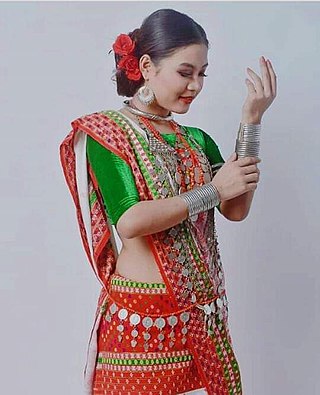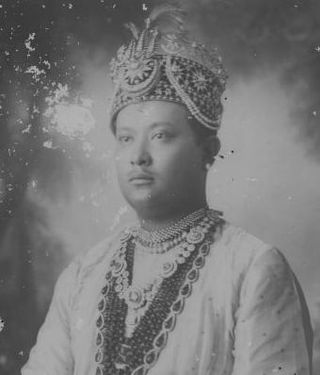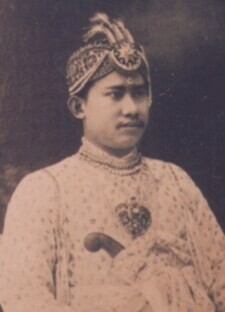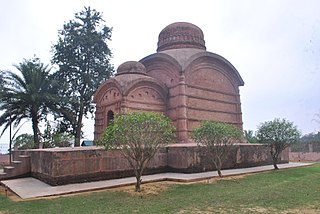
Agartala is the capital and the largest city of the Indian state of Tripura, situated on the banks of Haora River, about 2 kilometres (1.2 mi) east of the border with Bangladesh and about 2,499 km (1,552 mi) from the national capital, New Delhi. According to 2022 census, Agartala is the third largest city after Guwahati and Imphal in Northeast India. It is India's third international internet gateway and being developed under the Smart Cities Mission.

The State of Tripura, in northeastern India, has a long history. The Twipra Kingdom at its peak included the whole eastern region of Bengal from the Brahmaputra River in the north and west, the Bay of Bengal in the south and Burma to the east during the 14th and 15th centuries AD.

The Tripuri, are a Tibeto-Burman-speaking ethnic group of Northeast Indian state of Tripura. They are the descendants of the inhabitants of the Twipra/Tripura Kingdom in North-East India and Bangladesh. The Tripuri people through the Manikya dynasty ruled the Kingdom of Tripura for ~450 years until the kingdom joined the Indian Union on 15 October 1949.
The Pushbanta Palace also known as Kunjaban Palace is one of former royal palace of Tripura, it was built by Maharaja Birendra Kishore Manikya in 1917. It was the Raj Bhavan of Tripura till 2018, which later shifted. The palace is being developed as a national-level cultural museum.
The Twipra Kingdom was a Tibeto-Burman dynasty ethnic Kingdom of the Tripuri people (Tibeto-burman) in Northeast India.

The Manikya dynasty was the ruling house of the Twipra Kingdom and later the princely Tripura State, what is now the Indian state of Tripura. Ruling since the early 15th century, the dynasty at its height controlled a large swathe of the north-east of the Indian subcontinent. After coming under British influence, in 1761 they transitioned from feudal monarchs into rulers of a princely state, though the Manikyas maintain control of the region until 1949, when it ascended in union with India.

Maharaja Bir Bikram Kishore Manikya Debbarma Bahadur was a king of Tripura State.

Neermahal also known as Twijilikma Nuyung is a former royal palace of Tripura Kingdom, built by Maharaja Bir Bikram Kishore Manikya bahadur in 1930. It is also the largest water palace in India. The palace is situated in the middle of Rudrasagar Lake, in Melaghar 53 kilometers away from Agartala, the capital of Tripura.

The Ujjayanta Palace, also known as Nuyungma, in Tripuri, is the former royal palace of Tripura kingdom built by Maharaja Radha Kishore Manikya in 1901; and the name was given by Rabindranath Tagore. It housed the State Legislative Assembly up to 2011. At present, it is the State Museum of Tripura, which is located in the capital Agartala.

Umakanta Academy is an educational institute located in Agartala, India. Established in 1890, it is the oldest school in Tripura. It is affiliated to TBSE.

Birendra Kishore Manikya Debbarma Bahadur ascended the throne of the Kingdom of Tripura on 25 November 1909, at the age of 26.

Maharaja Radha Kishore Manikya of the Manikya Dynasty reigned as the king of Tripura State from 1897 to 1909. He has been described as one of the architects of modern Tripura.

Gomati district is a district of Tripura, India. This district was created in January 2012 when four new districts were created in Tripura, taking the number of districts in the state from four to eight. Udaipur is its headquarters.

Tripura State, also known as Hill Tipperah, was a princely state in India during the period of the British Raj and for some two years after the departure of the British. Its rulers belonged to the Manikya dynasty and until August 1947 the state was in a subsidiary alliance, from which it was released by the Indian Independence Act 1947. The state acceded to the newly independent Indian Union on 13 August 1947, and subsequently merged into the Indian Union in October 1949.
Maharaja Ishan Chandra Manikya of the Manikya Dynasty was the king of Tripura from 1849 to 1862
Maharaja Kirit Bikram Kishore Manikya Deb Barma Bahadur was the 185th and last King of Tripura, a princely state in northeastern India. His formal coronation was held in 1941, but he never gained the powers of a king.
Govinda Manikya was the Maharaja of Tripura from 1660 to 1661 and again from 1667 to 1676. Though viewed as a capable and successful ruler, Govinda's reign was interrupted by his temporary overthrow and usurpation by his younger brother.

Bhubaneswari Temple is a Hindu temple located in Tripura, India, in Rajnagar. Believed to be built in 1660–1675 AD, it is located next to the palace built by Maharaja Govinda Manikya. The temple is mentioned in Rabindranath Tagore's work.

Kokborok Cinema refers to the Kokborok language film industry in Tripura, India and among the Tripuri people. Tripura's Kokborok film industry began in 1986 with Longtharai (1986) directed by Dipak Bhattacharya adapted from Bimal Sinha's novel Karachi theke Longtharai depicting the struggle-ridden life of jhum cultivators in the rural hills of Longtharai followed by the Kokborok film Langmani Haduk (1993) directed by Ruhi Debbarma can be read as a critique of the modern regime. The Kokborok film Mathia (2004) directed by Joseph Pulinthanath, is the first International Award-winning Kokborok film.















